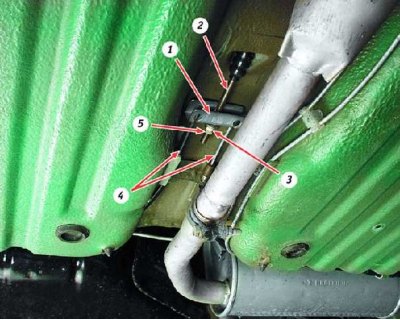
Stretching device (located under the bottom of the vehicle above the 1st stage muffler): 1 - equalizer; 2 - thrust; 3 - adjusting nut; 4 - cables; 5 - locknut

Before adjusting the parking brake, check the condition of the drive cables. If, when you press the cable, you feel that it does not move in the shell, then the cable "soured". In this case, the adjustment will not lead to a positive result and the cable must be replaced.
You will need two keys "at 13".
Before starting work: Adjust the clearances between the shoes and the brake drum.
Attention! On cars manufactured since 1995, the design of the parking brake lever has been changed (the first tooth of the sector is made double).
Attention! The parking brake must hold the vehicle on a 25% slope. On cars manufactured since 1995, the parking brake lever can be moved 2-8 clicks, and production before 1995 - 4-7 clicks.
Attention! If the lever is raised more than 8 clicks when the vehicle is braked with the parking brake (7 - for cars produced before 1995), the vehicle will not be held on a slope. If the lever travel is less than 2 clicks (4 - for cars manufactured before 1995), the wheels may be partially blocked while the vehicle is moving. In both cases, the parking brake must be adjusted.

1. Lower the parking brake lever all the way down. On pre-1995 vehicles, raise the lever 1-2 clicks.

2. Loosen the tensioner locknut while holding the adjusting nut from turning with another wrench.

3. Tighten the adjusting nut until the parking brake cable is tightened.

4. Check: The full stroke of the parking brake lever should be 2-4 clicks (on cars produced before 1995 - 4-5 clicks).

5. After checking travel, tighten the equalizer locknut while holding the adjusting nut with a wrench.

6. Lower the parking brake lever all the way down and turn the rear wheels by hand. They should rotate evenly, without jamming.
